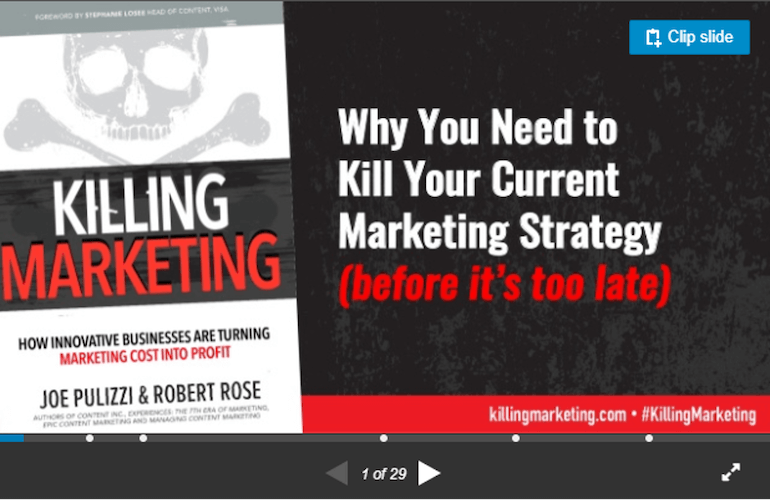One look at Twitter or LinkedIn and you’ll realize that every second person is a thought leader. But ‘thought leader’ is more than just a fancy tagline.
True thought leadership is about sharing meaningful insights, opinions, and points of view in your area of expertise with an aim to spark discussions, deliver value, and engage with your audience.
A subset of content marketing, thought leadership involves creating content to build trust and authority. This is particularly important in B2B marketing where decision-making processes are longer and more convoluted.
According to a LinkedIn-Edelman research study:
- 59% find an organization’s thought leadership to be more trustworthy than its marketing materials.
- 48% said that thought leadership can be effective in influencing purchasing decisions.

It’s clear — a smart thought leadership strategy has the potential to influence brand perception and buying behavior.
Here are five steps to develop a well-thought-out thought leadership strategy that drives growth.
1. Define and understand your target audience.
There’s a famous quote that says, “If you try to please everyone you’ll please no one.”
The same rule applies to your thought leadership strategy. Don’t try to create content for everybody. It’s exhausting.
The smarter way to approach this is to define your target audience. Identify the industry, industry size, set of companies, demographics, and job roles you want to target your content to.
Create buyer personas to understand their goals, challenges, and pain points. The more you learn about them, the better insights you get to inspire your thought leadership strategy.

Source: Venngage
Here are some tactics you can implement to understand your target audience:
- Conduct a survey or interview your existing customers.
- Be part of relevant forums and online communities in your niche.
- Gather information from your sales and customer service teams to uncover customer insights.
- Do social media listening to evaluate your audience’s needs and questions.
2. Find thought leadership content opportunities.
Let’s face it: recycling other people’s opinions is not thought leadership. Nor is sharing a salesy, self-serving article. For your thought leadership content to be effective, it needs to be:
- Insightful
- Relevant
- Authentic
Finding thought leadership content opportunities boils down to striking the right balance between your expertise and what your audience wants.
Here’s how you can find interesting thought leadership content opportunities in your niche:
- Offer a fresh perspective on a trend or pain point.
- Identify trends and explain what they mean for your audience.
- Provide a groundbreaking solution to an existing problem.
- Conduct original research and use data storytelling to share your findings.
- Share a personal experience.
- Challenge conventions and substantiate them with data or experience.
- Partner with industry experts and influencers.
Take American Express’ OPEN Forum for instance. It hosts articles written by experts with an aim to help small business owners and entrepreneurs with business advice. That’s not all, it also serves as a networking platform where registered users can share insights, ask questions, and attend online events.
The result? OPEN Forum happens to be American Express’s number one source for new leads.

3. Create valuable content for your thought leadership strategy.
CEO and Founder of Moz Rand Fishkin has interesting advice for creating thought leadership content. He says, “Non-obvious advice is very useful. Surprising, non-obvious advice is even better. Best of all is surprising, non-obvious advice delivered in a memorable way.”
It’s safe to say that if your content idea fits either of these criteria, it ought to be a winner.
Thought leadership content can take many forms such as:
- In-depth blog posts
- Simple infographics
- Whitepapers
- Ebooks
- Videos
- Podcasts
- Social media posts
- Research studies
- Webinars
- Guest posts
The formats (and channels) you opt for should depend on your target audience and the kind of information you want to deliver.
Apart from being meaningful and valuable, make sure you use visuals to present it in an engaging manner too. Visuals make it easier for people to consume, digest, and share information.
For example, let’s say you want to present complex data in the field of healthcare. A good way to communicate it would be to create a healthcare data visualization like the below. It makes the information memorable and presents data without overwhelming readers.

Source: Venngage
4. Identify distribution channels.
Is publishing a sole LinkedIn post to drive traffic to your ‘thought leadership’ article enough? Not quite. You should use a good mix of owned and earned media channels to distribute and amplify your content.
Repurpose the original piece of content for different channels to reach your target audience and boost visibility.
Here are some ways to distribute your thought leadership content and maximize its potential:
- Share it on social media platforms.
- Post it in relevant forums and online communities (e.g., LinkedIn groups, Slack communities, etc.).
- Repurpose it into infographics, videos, or SlideShare presentations.
- Submit guest posts to authoritative websites that speak to a similar target audience.
- Secure PR opportunities (e.g., appear as a guest on a podcast, get interviewed by a publication, etc.).
- Send out an email newsletter to your subscribers.
- Encourage employees to share the content on their channels.
Here’s a good example by bestselling author Joe Pulizzi. He created a SlideShare presentation with key takeaways from his book, Killing Marketing. It serves as a teaser to the book and entices people to read it.

5. Measure the success of your thought leadership strategy.
Imagine converting your podcast subscriber into a client or landing a client meeting after they happened to read your detailed research report? That’s thought leadership done well.
Let’s not forget that in the end, your thought leadership strategy needs to drive results. While it’s a long-term strategy, narrowing down metrics to measure will help you evaluate effectiveness.
Here are some key metrics you can track to measure a successful thought leadership strategy:
- Website traffic.
- Social media engagement (likes, comments, and shares).
- Referring domains or backlinks.
- Number of branded queries.
- Media mentions.
- Leads generated.
Make a thought leadership strategy work for your business.
Look at thought leadership as a long-term strategy — it requires commitment and consistency. It’s advisable to create a content calendar to support your thought leadership strategy. This will help you map it to your business goals and remain consistent.
It’s a crowded marketplace, but a thought leadership strategy packed with insight-led content delivered in an engaging way can set you apart from your competitors.
About the Author
Simki Dutta is a content marketer at Venngage, a free infographic maker and design platform. She writes about all things marketing and communications. Find her on Twitter and LinkedIn.






